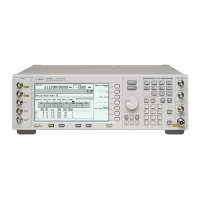92 Chapter 4
Basic Digital Operation
Arbitrary (ARB) Waveform File Headers
Arbitrary (ARB) Waveform File Headers
ARB file headers are used to save a modulation format’s signal generator settings and parameters so that the
waveform can be replicated when it is again played back by the dual ARB player. Once a modulation format,
such as Custom real-time, has been turned off, the waveform file is available only to the dual ARB player.
File header settings and parameters can be defined and saved along with the waveform file in the signal
generator’s non-volatile waveform memory (NVWFM). When you load a stored waveform file into volatile
waveform memory (WFM1), the file header information will be used to configure the ESG so that the dual
ARB player is set up the same way each time that the waveform file is played.
A default file header is automatically created whenever a waveform is generated (turning on a modulation
format), a waveform sequence created, or a waveform file downloaded to the ESG (Refer to the
E4428C/38C ESG Signal Generators Programming Guide for details on downloading files).
The following ESG setting and parameter information can be saved to the file header:
• ARB sample clock rate
• Runtime scaling (only in the dual ARB player)
• Marker 1–4 settings and routing functions (page 129)
— Polarity
—ALC hold
— RF blanking
• High crest mode (only in the dual ARB player)
• Modulator attenuation
• Modulator filter
• I/Q output filter (used when routing signals to the rear panel I/Q outputs)
• Other instrument optimization settings (for files generated by the ESG) that cannot be set by the user.
File headers can also store a user-defined 32-character text description of the waveform or sequence file. For
details on the file header settings and parameters, refer to “File Header Description” on page 95.
Creating a File Header
When you turn a modulation format on, the ESG automatically generates a temporary waveform file along
with a default marker file and default file header. The temporary waveform file resides in volatile waveform
memory (WFM1) and is named AUTOGEN_WAVEFORM. The default file header has no signal generator
settings saved to it and the default marker file consists of all zeros. Refer to the E4428C/38C ESG Signal
Generators Programming Guide for more information on marker files.

